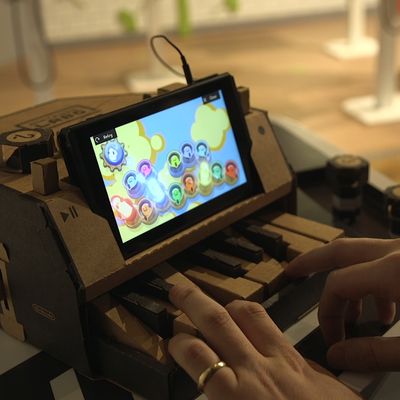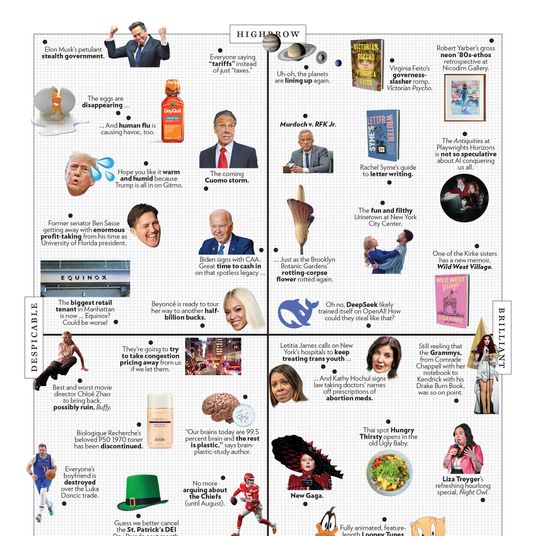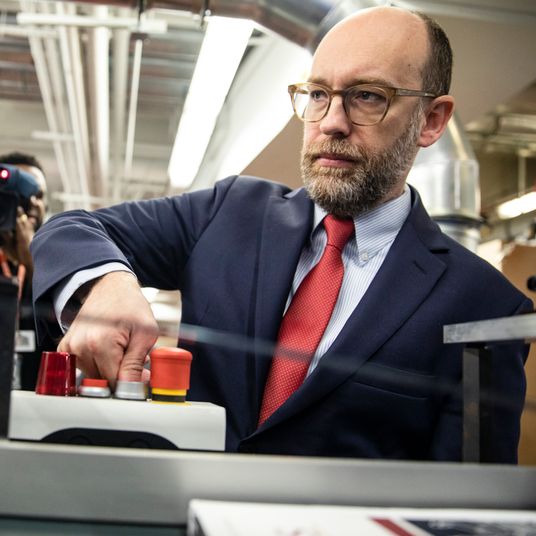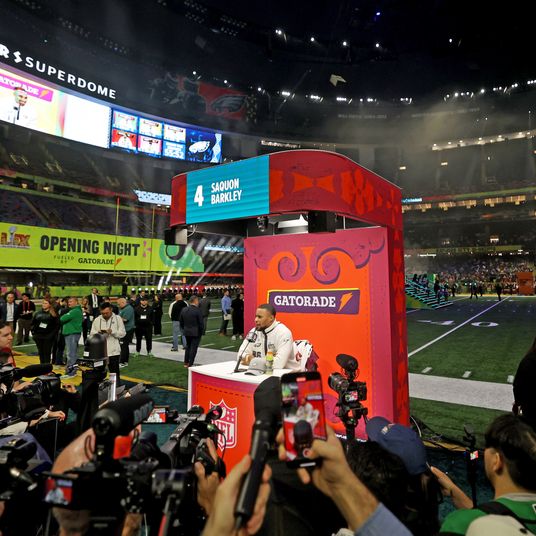
Nintendo’s new “Labo” build-and-play kits is Nintendo at its baffling, enthralling best. Less than a year after releasing the Nintendo Switch, the fastest-selling console in U.S. history, the venerable Japanese video-game company has decided that its next big move is going to be … folding cardboard robots?
I spent a morning last week in New York with a group of other journalists, building a few example cardboard creations, and trying out more pre-built demos of what will be on offer when the Nintendo Labo kits go on sale on April 20, and walked away impressed by what Nintendo had put together, and once again admiring the company for being willing to swing big when it comes to thinking about what a video-game system can do.
The cardboard kits — or as Nintendo calls them, “Toy-Cons,” a play on the Switch’s detachable side controllers, the “Joy-Cons” — are pure fun to build, in and of themselves. If you’ve ever messed around with paper craft (or just folded up origami or a paper airplane), you’ll get the basic idea here. Perforated cardboard is punched out of squares, folded at certain creases, and then slotted together.
At least in the kits we used, the cardboard held up admirably well during initial construction, and the instructions themselves were a joy to follow. Easy-to-follow 3-D animations showed how everything was supposed to go together, and you could use the Switch’s touchscreen to swivel those 3-D models around at will to get a better angle. If you missed where exactly something was supposed to fold underneath something else, you could easily rewind the instructions and keep on following along. (Ikea, steal this idea.) Creating simple remote-control cars took about ten minutes to build, while assembling a more complicated fishing rod probably would have taken me more like an hour — our time was cut short to go play demos before I could finish.
In a demo room, I got a chance to mess around with five different Labo creations: a Toy-Con House, a Toy-Con Fishing Rod, a Toy-Con Motorbike, a Toy-Con Piano, and a Toy-Con Robot. I found the fishing-rod game to be fun — you lower your hook into the ocean (a Nintendo Switch screen) and try to reel in bigger and bigger fish without breaking your line, and some clever sleight of hand from the Joy-Cons and a clicking tab inside the rod means that you never notice that you’re never actually, you know, reeling any actual line in. The 13-key piano was also fun, with different sets of sounds to play around with, depending on what module you slot into the piano, and a pitch shifter on the side for a cardboard-Moog experience. The motorbike was equally enjoyable: Turn the accelerator up on the right, and steer the bike by swinging the controls around. It was an old-school coin-operated arcade experience, built out of the same stuff I get my Amazon deliveries shipped in.
The Labo Home I was less sure of: It’s a set of mini-games (think racing a mining cart or trying to jump a rope) that you set up by inserting various cranks and button widgets into different positions around the house. It may be set up for longer-term play — there seemed to be some underlying ideas about collecting and decorating your house that I wasn’t getting. (It’s also, as anyone who has given a kid a gift knows, deeply difficult to discern what a kid will find fun versus what you will find fun.)
The Toy-Con Robot was obviously the big showstopper — about half the demo floor was given over to it. This was likely partly because you need a bit of room to play, and partly because, at first blush, it’s the most impressive Labo creation. You strap on a cardboard backpack, put your feet into stirrups, put on a cardboard visor, and hold on to cardboard handles. Lift your legs up and down to stomp around a city, punch with your hands to smash stuff up, and lower the visor down to go into a first-person mode. It was fun, but the controls felt clumsy at times (aided, I suppose, by my own clumsiness), and the game overall felt pretty uninspired. I was far more interested in the system of pulleys that controlled the robotic backpack than in the game itself.
The robot also presents parents with an interesting quandary. When the Labo goes on sale on April 20, there will be two kits available: the $70 Variety pack, which comes with the cardboard to build two RC cars, the house, the fishing rod, the motorbike, and the piano. And then there’s the $80 Robot Suit pack, which will come with … the robot. From my limited time, while the robot is more of an immediately appealing sugar-rush type of game — it’s hard to imagine the kid who doesn’t, at some point, dream of smashing their way through a city as a massive monster — it’s basically a one-and-done creation. You’ll spend a long afternoon building it with your kid, and then they’re off to the races. The cheaper variety pack not only offers up better games in general, but seems to offer more to appeal to the Labo’s real audience: parents. You get five different toys that you can build with your kid, meaning there’s more variety for them to mess around with (and more chances to remix the toys into something different — more on that in a second).
The key to how the Labo works is how many extra features were built into the Joy-Cons themselves. I was a bit surprised at how many extra features were built into the Joy-Con controllers when Nintendo announced the Switch. Extremely advanced rumble sounded interesting, but not groundbreaking, while having a infrared motion-tracking camera in the right Joy-Con was just mystifying. I have no idea if the Labo was already on the horizon when the Switch was announced, but the Labo puts a lot of the extra features in the Joy-Con to use. That supersensitive rumble? You can set it to a specific megahertz-frequency buzz to make those remote-control cars buzz around a table in a certain way. The infrared camera means that the reflective tape affixed to the ends of piano keys or inside of the fishing rod can be used to control everything — or get one of the RC cars to follow around the heat signature of your hand (or family pet).
Still, there was a part of me that was curious about how much creativity the Labo would really allow for. For years, there’s been a debate among parents about the “Lego set” problem. Put simply, do Lego sets — for example, a kit to build an X-wing fighter from Star Wars — engender or hinder creativity? With a Lego set, as with the pre-built Nintendo Labo creations, kids are following exact directions to build a creation someone else has thought of. Valuable skills to be sure (there’s plenty of adult life, kids will soon find out, that is largely about following directions that someone else has already thought of), but what about the pure creativity and fun of dumping out a huge pile of Legos and building your own janky spacecraft instead?
Enter Labo Garage, something we weren’t allowed to film, but was showed off for us behind closed doors. Labo Garage allows you to build your own Labo creations using simple input and output mechanics on the Nintendo Switch in a visual programming language (think making a flow chart instead of writing lines of code). It could be something as simple as making one Joy-Con vibrate when another is pressed, or have the Switch touchscreen play specific notes when specific parts of the screen were touched — or just remixing existing creations so that, say, the reel of the fishing rod would play a tune on a digital music box instead of hauling in virtual fish. It was hard to tell exactly how dynamic the Labo Garage will be — we were only shown a couple of demos — but it was a glimpse of something that could allow for that “dump out the Legos” creativity that building a fishing rod out of precut and creased cardboard just can’t. (It should also lead a flourishing DIY community of home-brew Labo toys built out of leftover cardboard or other materials — no more kits from Nintendo required.)
My reservations about the Labo kits are simple: How long does a cardboard toy really hold together? Even in the controlled environment of the Nintendo demo, I found small pieces starting to lose some of their action, or fall out of place a bit too easily. How does a fishing rod or a robot backpack and straps look after six months of use and abuse at the hands of a kid?
Regardless, my prediction is that this thing is gonna sell like crazy, particularly around the holiday season. Riding a motorcycle or doing some deep-sea fishing is more than enough to get a kid onboard, but the real audience here is parents. The chance to spend time building something with your kid, seeing how it all works, and at the end of the day, still letting them play a Nintendo Switch — meaning screen time for them, but less guilt for you — is an intoxicating combo.





























